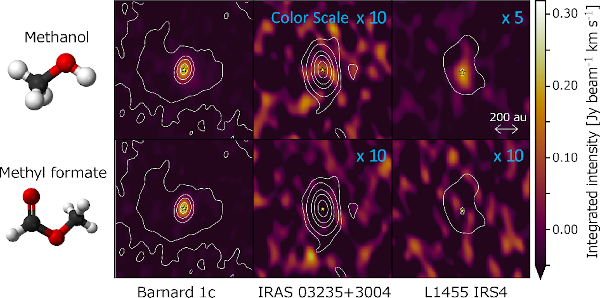Apr 12 2021
Scientists investigated the chemical composition of 50 protoplanetary-disk forming regions found in the Perseus Molecular Cloud and discovered that although the regions are in the same cloud, the amounts of their constituent complex organic molecules differ considerably.
 Distribution of molecular gas around the protostars. Color shows intensities of molecular emission, while contours show the thermal emission from dust. The existence of organic molecules appears to be irrelevant to the total amount of material. Image Credit: RIKEN.
Distribution of molecular gas around the protostars. Color shows intensities of molecular emission, while contours show the thermal emission from dust. The existence of organic molecules appears to be irrelevant to the total amount of material. Image Credit: RIKEN.
These findings were achieved by an international group of researchers headed by the RIKEN Cluster for Pioneering Research.
A fascinating fact is that the chemically rich young disks exhibit similar compositions of organic molecules. These results give way to a crucial question: do solar-like systems share a common chemistry at birth?
Giant radio pulses are a phenomenon in which very short, pulses of radio waves lasting only for a few milliseconds are emitted. Such pulses have been seen together with a dozen pulsars in the Milky Way galaxy. However, not much is known about the mechanism behind these pulses.
Scientists have hypothesized that they could even be the origin of 'fast radio bursts,' which are bursts of radio waves considered to have originated from energetic events in the extragalactic universe.
Previously, it was considered that complex organic molecules were not so common in the universe, and that this rarity could be why there is no evidence of life outside the earth. But in the past 20 years, it has become evident that these molecules are not rare.
Today, scientists have begun to systematically survey protoplanetary disks—disks where planets eventually form around a star—in the hope of determining how these molecules form, how common they are, and what impact they have on planetary systems.
Yao-Lun Yang, VICO Origins Postdoctoral Fellow, University of Virginia
Yang headed the research as a member of the Star and Planet Formation Laboratory in the RIKEN Cluster for Pioneering Research.
Researchers have analyzed individual systems, but there is very little comparative data to comprehend these young stars as a group.
The research team led by RIKEN resorted to using observations from the ALMA observatory in Chile, which enables researchers to investigate chemical compounds in protoplanetary disks due to its high resolution. More than three years were needed to complete the observations.
The team investigated the emission from organic molecules at particular frequencies in very young disks. They analyzed acetonitrile, methanol and two larger molecules—dimethyl ether and methyl formate.
The researchers discovered that different regions exhibited huge variations in the abundance of acetonitrile and methanol. However, interestingly, the relative abundance between both species was exceptionally similar.
This implies that there is a common production mechanism of these two molecules, and this give us important hints on how they form in space.
Yao-Lun Yang, VICO Origins Postdoctoral Fellow, University of Virginia
The abundances of dimethyl ether and methyl formate were found to be higher than methanol in denser regions. This denotes that some unique property of the denser conditions enables them to be abundant. The study results were reported last week by the American Astronomical Society in The Astrophysical Journal.
This raises important questions regarding how special the chemical environment of the infant Solar system is. We will be able to answer this question in the future by examining the chemical evolution of the gas surrounding young protostars. We hope that such knowledge will be a base for understanding the origin of life on the Earth.
Nami Sakai, Leader, Star and Planet Formation Laboratory, RIKEN Cluster for Pioneering Research
Journal Reference:
Yang, Y.-L., et al. (2021) The Perseus ALMA Chemistry Survey (PEACHES). I. The Complex Organic Molecules in Perseus Embedded Protostars. The Astrophysical Journal. doi.org/10.3847/1538-4357/abdfd6.